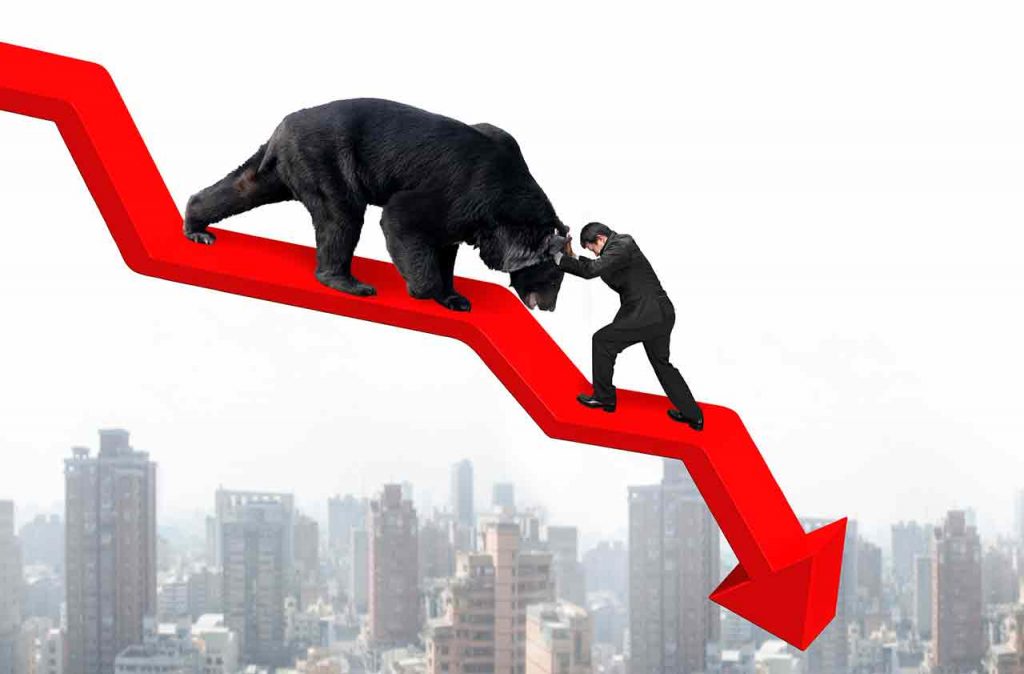Let’s go back to the fundamentals and go over the knowledge, character characteristics, and attitude you’ll need to make it through these times.
Bear markets happen sometimes. That doesn’t make it any easier to predict when one will happen, how long it will last, or how bad it will be. But you don’t have to be able to see into the future to take a few smart steps to reduce your losses in a bear market and improve your long-term investment returns at the same time.


- Bear markets are hard to predict and hard to trade in, but that doesn’t mean you should freak out.
- Older investors with big savings are more likely to lose money in a bear market than younger people with less money saved.
- By buying less risky stocks, you can reduce your losses in a bear market and get long-term benefits.
- Going into cash during a bear market is likely to hurt many investors’ returns when the market turns around.
What’s a Bear Market?
A bear market is when a broad index like the Standard & Poor’s 500 or the Nasdaq Composite shows a drop of 20% or more in the stock market. Because stock markets often go down by 5% or more, investors often don’t realize they’re in a bear market until they’ve lost a lot more than that. When investors add up the losses they’ve already taken, the growing uncertainty about the future, and the increased volatility of the market, they can become paralyzed by indecision and unable to take corrective steps while their portfolios take long-term damage.
Even though every bear market in history was followed by higher prices, it took a long time for many portfolios to get back on their feet, and some never did. The most important thing to do when investing is to keep your money safe, and nothing shows that better than a bear market.
Ways to Make Money & Stay Alive in Bear Market
1. Make a plan
Plan your trade, trade your plan. There should be a plan behind every trade and investment. Before you buy or sell, write down the most important questions. For example, what is the price you want to pay to get in? What is the price you want to leave at? Where do you stop losing money? How much do you have to lose? Why are you trading or investing in this thing, to begin with? When things aren’t stable, these questions are more important than ever. Get back to what you know.
2. Don’t be in a hurry
People act quickly when the market is volatile or when there is a market panic. People are often forced to act quickly without taking a moment to think about their original plan. This is wrong! Don’t hurry. Keep your cool and deal with what you’ve been given.
3. Don’t rush your entries
Traders and investors often talk about “Buying on Dips,” but this phrase explains what needs to be done. If you don’t have a plan, you don’t buy dips. You make a plan, wait for the right time to jump in, and then let the market come to you. When the market is going down and volatility is high, you must be patient and wait for the right time to get in. Make good use of limit orders.
4. Know how much time you have
Do you trade for a single day? How long? Or five years? These simple questions will help you remember what you’re trying to do and how quickly or slowly you should move. They will also tell you which chart you should be looking at, whether you should be looking at a 30-minute chart or a weekly chart that shows the price history for years.
5. Have a plan for getting out
With an exit strategy, you know where your stop loss is and where your profit target is, no matter what happens. No matter what goes right, wrong, or in the middle, you have a way out. Don’t let chance decide where you go in or out. Make a plan for how to get out of the trade before you make it, and stick to it.
6. Make the position size tighter
Your game plan needs to account for more volatility and uncertainty before it even starts. But a lot of new traders and investors forget to do this. If that sounds like you, it’s time to change your strategy and plan to account for bigger price swings and more volatility. The long-term trends that made a market what it was are less important now.
7. Zoom out to see what was going on in history
Get a wider view of your charts. Then keep zooming out. And now let’s get even further away. Circle the most recent candle, line, or price movement to keep track of where the price is now compared to where it came from. When in doubt, zoom out, says a proverb. Don’t get stuck in the present by only looking at the day or week. Instead, look into the price’s whole history. Find out about what has already happened.
8. Cash has a place
Want to dollar cost average into a trade? Want to purchase more? Want to do more business? To do that, you need money. Being able to take part in the volatility whenever you want is a comfort. Cash is a position, and this is a guarantee.
9. Don’t get scared, FUD, or FOMO
When feelings are strong, people can make some of the worst psychological mistakes. Fear, Uncertainty, and Doom are what FUD stands for. FOMO means the fear of missing out on something. These are two common feelings when the market is falling. On the one hand, everyone thinks the end is near, and on the other, every little rise is seen as the start of the next bull run. Don’t give in to these feelings.
10. Take a break 😀
Stepping back can help sometimes. Log out, close your apps, get outside and get some exercise. When you’re ready, you can go back to the markets. Your mind will be refreshed as well.
Summary
– It’s important to only put in as much money as you can afford to lose.
– During a bear market, another great way to keep yourself from feeling panicked and anxious is to avoid looking at your investment portfolio too often.
– Focusing on what you did or what you didn’t do can be very counterproductive because it can mess with your mood.
– Also, short-term investment strategies can be profitable and work, but it’s better to look at the stock market from a long-term perspective.
– During a bear market, it won’t help to calm your nerves to watch the news or read online articles about the stock market.
– Even if you try all of the above techniques, if you still feel stressed out and panicked all the time, the best thing to do would be to learn how to relax.
– Getting help from a pro can also help.
In conclusion
Bear markets aren’t a reason to get scared, but they are a good time to make sure your portfolio is diversified and low-risk. Know how much is at stake and how long you have to win back any money you lose.




